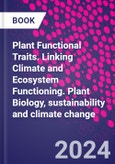Plant Function Traits: Linking Climate and Ecosystem Functioning, part of the Plant Biology, Sustainability and Climate Change series, presents a wholistic understanding of Plant Functional Traits. As global climate change advances, natural resources are facing increasing survival challenges, hence this book directly addresses that need, exploring the morphological, physiological, and phenological properties of a plant that can be used as a proxy to understand plant environment interactions. Users will find great illustrations throughout individual chapters, along with case studies that demonstrate applications of functional traits in classifying vegetation of a region into distinct type groups as Plant Functional Types (PFTs).
Additional information includes applications in the development of new generation of Dynamic Global Vegetation Model (DGVM) and an understanding of the response of vegetation to changing environments.
Table of Contents
1. Plant functional traits: The scientific basis and their significance in climate change impact studies
Section I: Plant functional traits: the scientific basis
2. Plant functional traits: synthesis of current status and available information
3. Unravelling the relationship between plant functional traits and environment
4. Functional traits as determinants of plant performance
5. Driving mechanism of functional trait variations in a forest ecosystem
6. Belowground traits and their importance in ecological studies
Section II: Functional relationship between trait and environment
7. A review of plant-environment interactions
8. Significance of trait and environment relations in ecological studies
9. Plant functional traits for assessing impacts of climate change
10. Traits explaining occurrence and abundance of plants
11. Environmental conditions influencing the distribution of plant functional traits
Section III: Ecosystem services and plant functional traits
12. Plant functional traits and soil carbon dynamics
13. Selection of appropriate functional traits and its application to evaluate ecosystem service
14. Trait-based selection of suitable plant species to restore the degraded ecosystems
15. Monitoring canopy functional traits using remote sensing
16. Hyperspectral remote sensing for monitoring plant functional traits
17. Monitoring and modelling of functional relationship of plant traits with environment
18. Investigating the origins and effects of intraspecific trait variations
19. Monitoring of plant functional traits as indicator of air quality
20. Synthesizing functional trait data to understand global patterns and processes of vegetation: gaps and biases
Section V: Functional traits and vegetation models
21. Linking biophysical models with functional traits for ecological studies
22. Representing functional traits in earth system models to understand coupled biosphere-atmosphere interactions
23. Modelling the relationships between traits, climate, and life history strategies








